- 易迪拓培训,专注于微波、射频、天线设计工程师的培养
CST仿真T型不等功率分配器有问
录入:edatop.com 点击:
我在使用CST仿真2.45GHz 的T型不等功分器时,出现问题,现将问题描述如下:
首先仿真功率比为1.55:1的T型功分器[attachment=60626]
之所以采取这样的结构设计,是因为功率比很大的情况下,所需的微带的电阻很大,所以微带线很细,不容易设计,所以采取了论文中的改变参考臂的设计思想,所以根据功率比知道,只要Z4=k^2*Z3(K^2=1.55),且1/Z4+1/Z3=1/Z2即可,所以选择合适的Z3,Z4和Z2,则能够既能够保证功率比,又能够保证实际的可实现性,最终选择Z2=36.5,Z3=60,Z4=93(满足Z4=k^2*Z3(K^2=1.55),且1/Z4+1/Z3=1/Z2),Z1,Z5,Z6是起着阻抗匹配的作用(长度均为1/4波长)。
最终结果如图:
[attachment=60628]
实际功率比1.53:1,马马虎虎能够满足,接下来,我希望将其中的一个输出端口再进行等功分,即整个模型有三个输出端口:
[attachment=60629]
等功分的那个端口的设计思想基本上和之前的一样,将原来的50Ω直接分成两个100Ω,100欧姆通过70.7的电阻和输出的50欧姆进行匹配,没有等功分的那个端口把原来的50欧姆直接延长,模型如上所示。
[attachment=60630]
并且能量曲线没有下降到-30dB
[attachment=60631]
仿真有警告,并且S参数图形很差,警告如下:
Maximum simulation time reached, solver stopped.
Please note that the steady state energy criterion has not been satisfied. More...
1 warning occurred.
通过点击More,出现:
This page contains a list of the most important warning and error messages in the context of the transient solver together with a detailed explanation of the meaning and proposal for handling and resolution.
Maximum number of pulse widths simulated, solver stopped. / Maximum simulation time reached, solver stopped. Please note that the steady state energy criterion has not been satisfied.
The transient solver operates with a time pulse as excitation, and the simulation stops when one of the following conditions are met:
•
Either the remaining energy in the calculation domain as well as the port signals have decreased to the steady state value specified on the time domain solver parameter page in the Accuracy field.
•
The simulation time reaches the maximum solver duration, either defined as Time, Number of pulses or Propagation distance on the Steady state tab on the Special Time Domain Solver Parameter page.
The warning appears when the latter condition was satisfied first before the accuracy level has been reached. This means the energy level remaining in the structure is still bigger than the specified steady state value. Usually this is the case for resonating (energy stays inside the structure for a long time) or large structures (it takes a long time for a pulse to penetrate through the structure). The extra energy would appear as a truncation error, which causes some ripples in the S-parameter curves.
Recommended solutions are the following:
•
For non-resonating structures, the maximum solver duration setting can be adjusted, with the appropriate choice of defining number of pulses or a time or propagation distance setting.
•
For resonating structures a much better approach would be to activate the Autoregressive Filter (see advanced Topics manual) on the AR Filter tab on the Special Time Domain Solver Parameter page, which allows to shorten the simulation time and in addition to avoid the truncation error.
不知道出现这种情况该怎么解决,因为理论上分析的应该没错,实际不知道是模型有问题还是软件设置有问题,求教,
首先仿真功率比为1.55:1的T型功分器[attachment=60626]
之所以采取这样的结构设计,是因为功率比很大的情况下,所需的微带的电阻很大,所以微带线很细,不容易设计,所以采取了论文中的改变参考臂的设计思想,所以根据功率比知道,只要Z4=k^2*Z3(K^2=1.55),且1/Z4+1/Z3=1/Z2即可,所以选择合适的Z3,Z4和Z2,则能够既能够保证功率比,又能够保证实际的可实现性,最终选择Z2=36.5,Z3=60,Z4=93(满足Z4=k^2*Z3(K^2=1.55),且1/Z4+1/Z3=1/Z2),Z1,Z5,Z6是起着阻抗匹配的作用(长度均为1/4波长)。
最终结果如图:
[attachment=60628]
实际功率比1.53:1,马马虎虎能够满足,接下来,我希望将其中的一个输出端口再进行等功分,即整个模型有三个输出端口:
[attachment=60629]
等功分的那个端口的设计思想基本上和之前的一样,将原来的50Ω直接分成两个100Ω,100欧姆通过70.7的电阻和输出的50欧姆进行匹配,没有等功分的那个端口把原来的50欧姆直接延长,模型如上所示。
[attachment=60630]
并且能量曲线没有下降到-30dB
[attachment=60631]
仿真有警告,并且S参数图形很差,警告如下:
Maximum simulation time reached, solver stopped.
Please note that the steady state energy criterion has not been satisfied. More...
1 warning occurred.
通过点击More,出现:
This page contains a list of the most important warning and error messages in the context of the transient solver together with a detailed explanation of the meaning and proposal for handling and resolution.
Maximum number of pulse widths simulated, solver stopped. / Maximum simulation time reached, solver stopped. Please note that the steady state energy criterion has not been satisfied.
The transient solver operates with a time pulse as excitation, and the simulation stops when one of the following conditions are met:
•
Either the remaining energy in the calculation domain as well as the port signals have decreased to the steady state value specified on the time domain solver parameter page in the Accuracy field.
•
The simulation time reaches the maximum solver duration, either defined as Time, Number of pulses or Propagation distance on the Steady state tab on the Special Time Domain Solver Parameter page.
The warning appears when the latter condition was satisfied first before the accuracy level has been reached. This means the energy level remaining in the structure is still bigger than the specified steady state value. Usually this is the case for resonating (energy stays inside the structure for a long time) or large structures (it takes a long time for a pulse to penetrate through the structure). The extra energy would appear as a truncation error, which causes some ripples in the S-parameter curves.
Recommended solutions are the following:
•
For non-resonating structures, the maximum solver duration setting can be adjusted, with the appropriate choice of defining number of pulses or a time or propagation distance setting.
•
For resonating structures a much better approach would be to activate the Autoregressive Filter (see advanced Topics manual) on the AR Filter tab on the Special Time Domain Solver Parameter page, which allows to shorten the simulation time and in addition to avoid the truncation error.
不知道出现这种情况该怎么解决,因为理论上分析的应该没错,实际不知道是模型有问题还是软件设置有问题,求教,
网友回复:
图片怎么没了,我重新传一下
网友回复:
从上到下依次为
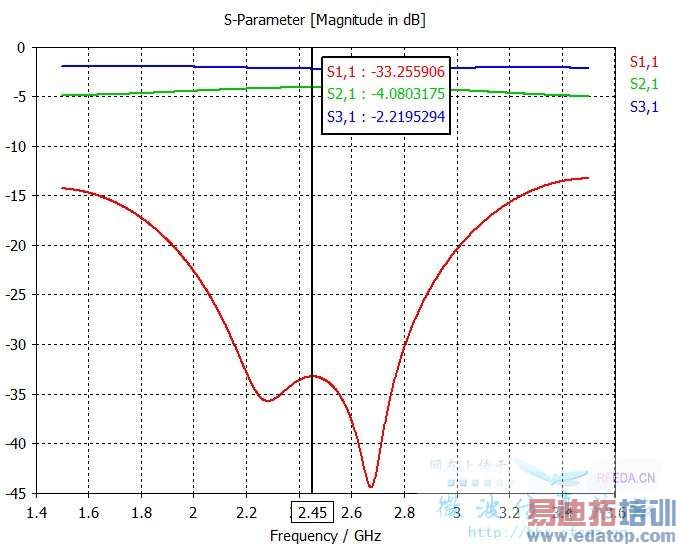
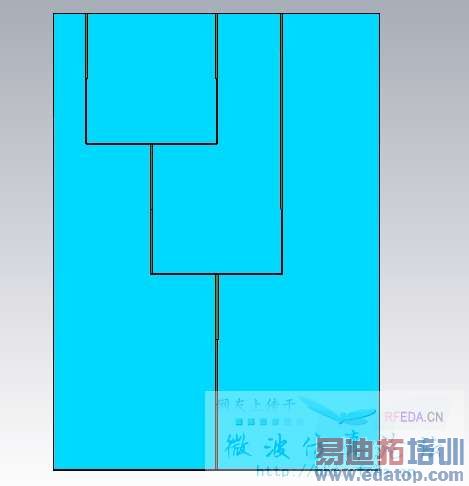
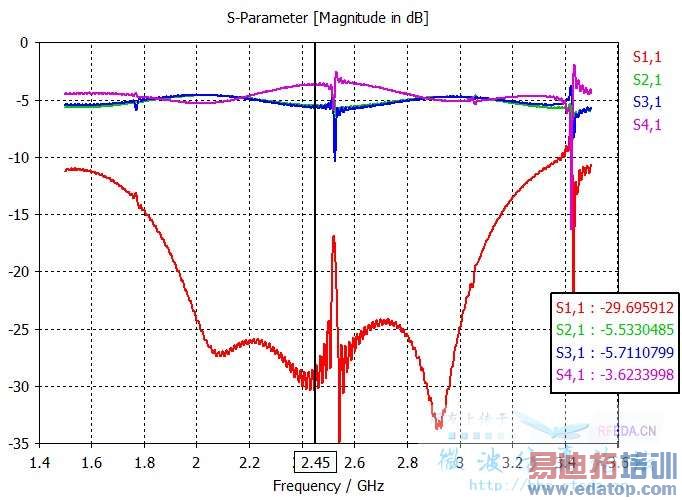
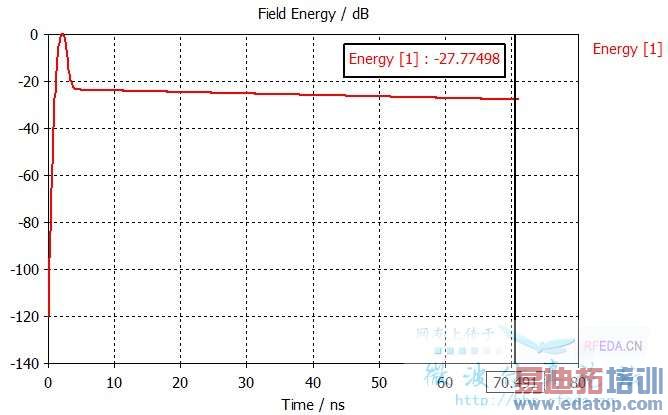
网友回复:
能将你的模型上传么?想看看你的网格设置
网友回复:
已经上传了,麻烦你了
网友回复:
(588 K) 7
网友回复:
主要是你的背景材料中的距离设置的太小了,估计有点空间谐振了,我将背景材料中的距离Upper Z设置为了10,之后进行了仿真,结果如下:
网友回复:
能量可以很快衰减:
网友回复:
[attachment=60647]
我选的就是这个模型,当把模型建好后,端口什么的设置完成后,默认的空气盒子的大小就是贴着波端口的上面的,是不是要自己重新设置啊
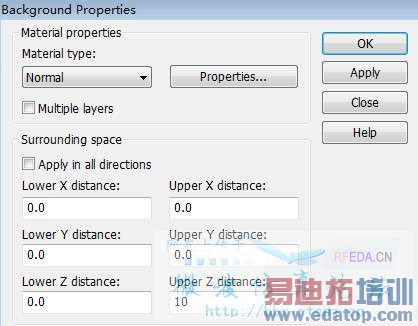
这样就可以了吧,还有就是,默认的都是电边界也不需要修改吧
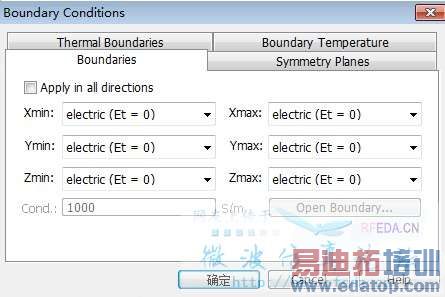
网友回复:
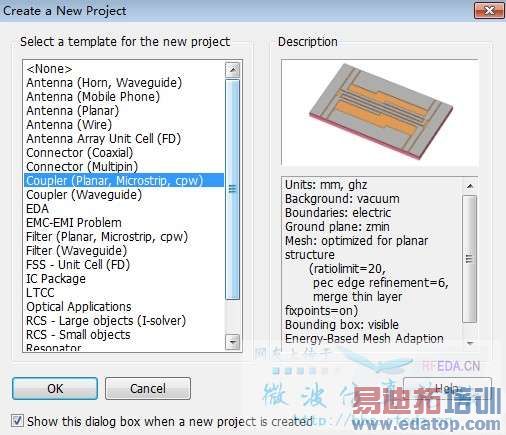 我选的这个模型应该没问题吧
我选的这个模型应该没问题吧
申明:网友回复良莠不齐,仅供参考。如需专业解答,请学习易迪拓培训专家讲授的CST视频培训教程。

